Bruker:Oddeivind/sandkasse2
Belgia er en føderal stat bestående av tre samfunn, tre regioner og fire språkområder.
Språkområdene blei oppretta den 2. august 1963. Oppdelinga i språkområder blei en del av grunnloven i 1970.[1] Through constitutional reforms in the 1970s and 1980s, regionalisation of the unitary state led to a three-tiered federation: federal, regional, and community governments were created, a compromise designed to minimize linguistic, cultural, social and economic tensions.[2]
Country subdivisions[rediger | rediger kilde]
The Flemish Region (Flanders) and the Walloon Region (Wallonia) each comprise five provinces; the third region, Brussels-Capital Region, is neither a province, nor does it contain any.
Together, these comprise 589 municipalities, which in general consist of several sub-municipalities (which were independent municipalities before a municipal restructuring in early 1977).
The communities, regions, language areas, municipalities, and provinces, are the five most important subnational entities of Belgium, as laid out in the Belgian constitution. Lesser subnational entities include the intra-municipal districts, the administrative, the electoral and the judicial arrondissements, police districts, as well as the new inter-municipal police zones (lower level than the police districts).
All these entities have geographical boundaries: the language areas, the communities, the regions, the provinces and the municipalities. The language areas have no offices or powers and exist de facto as geographical circumscriptions, serving only to delineate the empowered subdivisions. The institutional communities are thus equally geographically determined. Belgian Communities do not officially refer directly to groups of people but rather to specific political, linguistic and cultural competencies of the country. There is no subnationality in Belgium.
All Communities thus have a precise and legally established area where they can exercise their competencies: the Flemish Community has legal authority (for its Community competencies) only within the Dutch language area (which coincides with the Flemish Region) and bilingual Brussels-Capital language area (which coincides with the Region by that name); the French-speaking Community analogously has powers only within the French language area of the Walloon Region and in the Brussels-Capital Region, and the German Community in the German language area, which is a small part of the province of Liège in the Walloon region, and borders Germany.
The three regions are:
- the Brussels-Capital Region
- the Flemish Region
- the Walloon Region
The three communities are:
- the Dutch-speaking Vlaamse Gemeenschap ("Flemish Community")
- the French-speaking Communauté Française ("French Community")
- the German-speaking Deutschsprachige Gemeinschaft ("German-speaking Community").
The four language areas (as taalgebieden in Dutch and Sprachgebiete in German), occasionally referred to as linguistic regions (from French régions linguistiques), are:
- the Dutch language area (Flanders)
- the Bilingual area Brussels-Capital
- the French language area (Wallonia)[3][4][5]
- the German language area (which has specific language facilities for French-speakers).
The constitutional language areas determine the official languages in their municipalities, as well as the geographical limits of the for specific matters empowered institutions:
| Public services rendered in the language of individuals expressing themselves… |
the Communities | the Regions (and their provinces) | the Federal State |
||||||||
|---|---|---|---|---|---|---|---|---|---|---|---|
| Dutch [6] |
French | German- speaking |
Dutch [6] |
Walloon | Brussels- Capital | ||||||
| …in Dutch | …in French | …in German | |||||||||
| Dutch language area | Mal:Y | in 12 municipalities (limited to 'facilities') |
- | Mal:Y | - | - | Mal:Y | - | - | Mal:Y | |
| French language area | in 4 municipalities (limited to 'facilities') |
Mal:Y | in 2 municipalities (limited to 'facilities') |
- | Mal:Y | - | - | Mal:Y | - | Mal:Y | |
| Bilingual area Brussels-Capital | Mal:Y | Mal:Y | - | Mal:Y | Mal:Y | - | - | - | Mal:Y | Mal:Y | |
| German language area | - | in all 9 municipalities (limited to 'facilities') |
Mal:Y | - | - | Mal:Y | - | Mal:Y | - | Mal:Y | |
| By Law, inhabitants of 27[7] municipalities can ask limited services to be rendered in a neighbour language, forming 'facilities' for them. 'Facilities' exist only in specific municipalities near the borders of the Flemish with the Walloon and with the Brussels-Capital Regions, and in Walloon Region also in 2 municipalities bordering its German language area as well as for French-speakers throughout the latter area. | |||||||||||
Although this would allow for seven parliaments and governments, when the Communities and Regions were created in 1980, Flemish politicians decided to officially merge the Flemish Region into the Flemish Community, with one parliament, one government and one administration, exercising both regional and community competencies, although Flemish parliamentarians from the Brussels-Capital Region cannot vote on competencies of the Flemish Region; thus in the Dutch language area a single institutional body of parliament and government is empowered for all except federal and specific municipal matters.[6][2]
Competences[rediger | rediger kilde]
The Federal State retains a considerable "common heritage". This includes justice, defence, federal police, social security, monetary policy, public debt and other aspects of public finances, nuclear energy, State-owned companies (such as the Post Office and —an exception on regionalized transport— Belgian Railways). It is responsible for the obligations of Belgium and its federalized institutions towards the European Union and NATO. It controls substantial parts of public health, home affairs and foreign affairs.[8]
Communities exercise competences only within linguistically determined geographical boundaries, originally oriented towards the individuals of a Community's language: culture (including audiovisual media), education, the use of the relevant language. Extensions to personal matters less directly attributed to the language comprise health policy (curative and preventive medicine) and assistance to individuals (protection of youth, social welfare, aid to families, immigrant assistance services, etc.)[9]
Regions have authority in fields connected with their territory in the widest meaning of the term, thus relating to the economy, employment, agriculture, water policy, housing, public works, energy, transport, the environment, town and country planning, nature conservation, credit, and foreign trade. They supervise the provinces, municipalities and intercommunal utility companies.[10]
In several fields, the different levels each have their own say on specificities. On education for instance, the autonomy of the Communities does neither include decisions about the compulsory aspect nor setting minimum requirements for awarding qualifications, which remain federal matters.[8] Each level can be involved in scientific research and international relations associated with its powers.[9][10]
Communities[rediger | rediger kilde]
| Communities | Flemish Community | French Community | German-speaking Community |
| Dutch name | Vlaamse Gemeenschap | (Franse Gemeenschap) | (Duitstalige Gemeenschap) |
| French name | (Communauté flamande) | Communauté française | (Communauté germanophone) |
| German name | (Flämische Gemeinschaft) | (Französische Gemeinschaft) | Deutschsprachige Gemeinschaft |
| Location | 
|
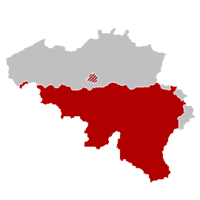
|
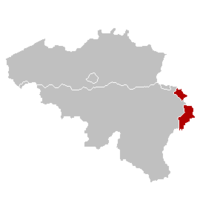
|
| Flag | 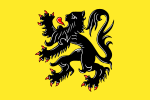
|
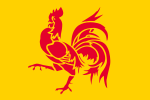
|

|
| Capital | Brussels (joint with Flemish region) |
Brussels | Eupen |
| Minister President | Kris Peeters (list) (joint with Flemish region) |
Rudy Demotte (list) | Karl-Heinz Lambertz (list) |
| Web site | www.flanders.be | www.cfwb.be | www.dglive.be |
Regions[rediger | rediger kilde]
| Region | Flemish Region | Walloon Region | Brussels-Capital Region |
| Dutch name | Vlaams Gewest | (Waals Gewest) | Brussels Hoofdstedelijk Gewest |
| French name | (Région flamande) | Région wallonne | Région de Bruxelles-Capitale |
| German name | (Flämische Region) | Wallonische Region | (Region Brüssel-Hauptstadt) |
| Location | 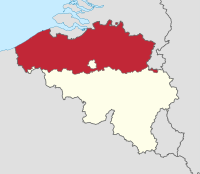
|

|
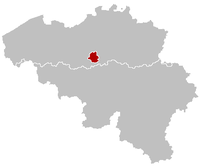
|
| Flag | 
|

|
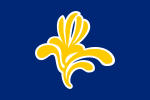
|
| Capital | Brussels | Namur | Brussels |
| ISO 3166-2:BE | BE-BRU | ||
| Area | 13,522 km² (44.29% of Belgium) |
16,844 km² (55.18% of Belgium) |
161 km² (0.53% of Belgium) |
| Provinces | Antwerp Limburg Flemish Brabant East Flanders West Flanders |
Hainaut Walloon Brabant Namur Liège Luxembourg |
none |
| Municipalities | 308 | 262 | 19 |
| Population | 6,078,600 [2006][11] (58% of Belgium) |
3,413,978 [2006][11] (32% of Belgium) |
1,018,804 [2006][11] (10% of Belgium) |
| Population density | 442/km² | 199/km² | 6,238/km² |
| Minister-President | Kris Peeters (list) | Rudy Demotte (list) | Charles Picqué (list) |
| Web site | www.flanders.be | www.wallonie.be | www.brussels.irisnet.be |
Flemish Region[rediger | rediger kilde]
Utdypende artikkel: Flemish Region
The Flemish Region or Flanders (Vlaams Gewest or Vlaanderen in Dutch) occupies the northern part of Belgium. It has a surface area of 13,522 km² (44.29% of Belgium) and is divided into 5 provinces which contain a total of 308 municipalities.
The official language is Dutch. French can be used for certain administrative purposes in a neat dozen so-called "municipalities with language facilities" around the Brussels-Capital Region and at the border with the Walloon Region.
Brussels is part of Flanders, but only for all its Flemish inhabitants and local institutions (which indeed live in both the Flemish Region and the Brussels Region). It is also the official capital of Flanders. The Flemish Region has no institutions on its own. Its competencies were transferred to the unified Flemish institutions that combine both regional and community competencies. As a result, the Flemish region (nor the Flemish Community) has not a single civil servant of its own, no legislative council etc. Since, the unified institutions exercise all their power and competencies (see also: Flemish Parliament and Flemish Government).
Provinces[rediger | rediger kilde]
Utdypende artikkel: Provinces of Belgium
- Flanders contains five provinces: West Flanders, East Flanders, Antwerp, Flemish Brabant, Limburg
Brussels-Capital Region[rediger | rediger kilde]
Utdypende artikkel: Brussels-Capital Region
The Brussels-Capital Region (Brussels Hoofdstedelijk Gewest in Dutch, Région de Bruxelles-Capitale in French, Die Region Brüssel-Hauptstadt in German) or Brussels Region is centrally located and completely surrounded by the province of Flemish Brabant and thus by the Flemish Region. With a surface area of 162 km² (0.53% of Belgium) it is the smallest of the three regions. It contains Brussels, which acts both as federal and regional capital, and in total 19 municipalities. The population breakdown in the region is as follows: ±85% French-speaking, ±15% Dutch-speaking. It's official languages are both Dutch and French. The Brussels Capital Region contains only one administrative district, the Brussels Capital District. However, for many administrative and juridical purposes (e.g. electoral purpose), it forms a district with surrounding Flemish areas (something considered by competent judicial authorities as contrary to the Belgian Constitution). However, this often creates dysfunctions in the public service, e.g. whenever mono-lingual French-speaking civil servants or policemen operate in the mono-lingual Flemish municipalities.
Although some believe, wrongly, that the capital of Belgium is the entire Brussels-Capital Region, article 194 of the Belgian Constitution lays down that the capital of Belgium is the City of Brussels municipality.[12] Arguments that article 194's use of lower case for "ville de Bruxelles" and "stad Brussel" makes a subtle difference and means that greater Brussels being represented as the capital cannot be legally defended. However, although the City of Brussels is the official capital, the funds allowed by the federation and region for the representative role of the capital are divided among the 19 municipalities, and some national institutions are sited in the other 18 municipalities. Thus, while de jure only the City of Brussels is entitled to the title of capital city of Belgium, de facto the entire Region plays this role.
Among the national institutions outside the city of Brussels, one can find many buildings of national ministries, including the main building of the ministry of pensions, the military headquarters (in Evere), the national telecommunications company. Finally, also the particular name of the Brussels region, with the explicit 'capital' in it, is a very symbolic proof of the ambitions from the main local politicians, and of the recognition for that capital function in Belgian legislation.
The Brussels Region does not belong to any of the provinces. Within the Region, 99% of the provincial competencies are assumed by the Brussels regional institutions. Remaining is only the governor of Brussels-Capital and some aides.
Within Brussels, the two Communities have their own institutions that act as "intermediary levels" of government and public service, sitting below the Community institutions, and above the municipal institutions:
- Vlaamse gemeenschapscommissie (VGC) and its administration;
- Commission Communautaire Française (COCOF) and its executive commission and its administration.
Walloon Region[rediger | rediger kilde]
Utdypende artikkel: Walloon Region
The Walloon Region or Wallonia (Région Wallonne or Wallonie in French) occupies the southern part of Belgium. It has a surface area of 16,844 km² (55.18% of Belgium) and is also divided into 5 provinces which contain a total of 262 municipalities. Its capital is Namur.
The official languages are French and, only in the nine eastern municipalities that form the German-speaking Community near the German border, which were ceded by Germany after WWI, German. Dutch however, may be used for administrative purposes in the four municipalities with language facilities at the border with Flanders, and German in two such municipalities near the German-speaking Community.
Provinces[rediger | rediger kilde]
Utdypende artikkel: Provinces of Belgium
- Walloon Region contains five provinces: Hainaut, Walloon Brabant, Namur, Luxembourg, Liège
See also[rediger | rediger kilde]
References[rediger | rediger kilde]
- ^ «Als goede buren – Vlaanderen en de taalwetgeving – Taalgrens en taalgebieden» (Dutch). Vlaanderen.be. Besøkt 10. juli 2007. Ekstern lenke i
|utgiver=(hjelp) - ^ a b «Politics — State structure». Flanders.be. Flemish Government. Besøkt 24. mai 2007.
- ^ Official website of Belgian state Democratic structure of Belgium (fransk)
- ^ Mal:Fr Tribunal Européen des Droits de l'Homme, Publications. Série A: Arrêts Et Décisions, Strasbourg, 1961, p. 5.
- ^ The French Community of Belgium also called Wallonia-Brussel Community is composed by the bilingual language area (Brussel) and the french language area (Wallonia) [1]
- ^ a b c Footnote: The Constitution set out seven institutions each of which can have a parliament, government and administration. In fact there are only six such bodies because the Flemish Region merged into the Flemish Community. This single Flemish body thus exercises powers about Community matters in the bilingual area of Brussels-Capital and in the Dutch language area, and about Regional matters only in the latter.
- ^ Footnote: Apart from the municipalities with language facilities for individuals, the French language area has three more municipalities in which the second language in education legally has to be either Dutch or German, whereas in its municipalities without special status this would also allow for English. Lebrun, Sophie (7. januar 2003). «Langues à l'école: imposées ou au choix, un peu ou beaucoup» (French). La Libre Belgique's web site. Besøkt 17. august 2007.
- ^ a b «The Federal Government's Powers». .be Portal. Belgian Federal Government. Besøkt 23. mai 2007.
- ^ a b «The Communities». .be Portal. Belgian Federal Government. Besøkt 23. mai 2007.
- ^ a b «The Regions». .be Portal. Belgian Federal Government. Besøkt 23. mai 2007.
- ^ a b c «Structuur van de bevolking – België / Brussels Hoofdstedelijk Gewest / Vlaams Gewest / Waals Gewest (2000-2006)» (asp) (Dutch). FOD/SPF Economie (Federal Government Service Economy) – Algemene Directie Statistiek en Economische Informatie. © 1998/2007. Besøkt 8. mai 2007. Sjekk datoverdier i
|dato=(hjelp) - ^ http://www.fed-parl.be/gwuk0015.htm#E11E15
